导图社区 6-2Road to Civil War思维导图
- 48
- 1
- 1
- 举报
6-2Road to Civil War思维导图
英美概况第六章的思维导图,必备复习资料分享,方便大家备考时翻阅查看,提高复习效率,希望对大家备考有所帮助
编辑于2021-06-18 11:50:49- 大学英美概况第四版
- 相似推荐
- 大纲
Road to the civil war
Economic antagonism between north & south
North
harsh climate, poor soil quality
Industry & commerce
Factory-based industry
Industry is the king
Free slaves
became workers
South
75% plantation
Cotton (slavery as a necessary evil)
one-crop economy
Cotton is the king
slavery-social institution
White
Wealthy
profit
Poor
psychological comfort
Eli Whitney's cotton gin
轧棉机
allow North & South change machine parts instead of the whole machine
reduce loss
South relied on slaves more(plant and care about cottons)
Moral factor
Uncle Tom's Cabin-Harriet Beecher Stowe(abolitionist)
Describe slaves as kind and loyal to pwners
contrary to reality
against the Bible
"All men are brothers"
Aroused hatred between South and North
North
More people disliked slavery
Criticized landowners in South
ask the end of slavery
South
Many considered the book a liar
They insisted they treated blacks well
Factories treated workers and slaves cruelly
Call slaves in North "wage labor"
Westward Movement
Missouri Queation
Balance of the power of free states and slave states in Congress broke
Senate
Each state send two equal numbers of representatives
the House of Representatives
Based on population
Missouri Compromise 1821
Balance of slave & free state
American territory
Apply for statehood
Missouri become a slave state
Maine was admitted as a free state
Balance was kept
Compromise of 1850
California became a free state
Balance was broke again
Rest of the Mexican Cession was divided into Utah(UT) and New Mexico(NM)
People in UT and NW used popular sovereignty to decide on the slavery issue
人民主权论
Gave more power to the state government
The slave trade ended in Washington, D.C.
The Fugitive Slave Law was passed
逃亡者
All Americans were required to help catch runaway slaves
Infuriated northerners
Ignore
Were forced to oppose slavery
Frederick Douglass got free
Slave narrative
Made speeches to oppose the Law
Kansas-Nebraska Act
Nebraska Territory was divided into Nebraska(NE) and Kansas(KS)
popular sovereignty
Seemingly democratic
People living in this area decide the future of it
Bleeding Kansas
N came to keep KS a slave state
S came to keep KS a free state
Both sides claimed victory on the vote
Northerners Criticize Southerners on newspapers
Southerners break into the newspaper office and throw the printing press into Missouri River
John Brown(abolitionist) 1856
Murdered five proslavery men
was hanged
Effects of John Brown's Raid
Aroused widespread support for Brown in the North
Increased southern fears that abolitionists would inspire slave revolts
United white southerners in support of the South
Probably speed the coming of the Civil War
Lincoln and Douglass debate for senator(1858)
Emphasized the division over Kansas-Nebraska Act and the Dred Scott decision
Brought Lincoln's opposition to slavery's spread to a national audience
Caused Douglas to lose support in the North and the South
The Election of 1860
Split in Democratic Party allowed Lincoln's election as president
Left both houses of Congress in northern hands with an opponent of slavery heading the executive
Secession
Fears in South Carolina that a northern-controlled government would act against slavery; South Carolina withdrew from the Union
Several other slave states followed South Carolina's lead and formed the Confederate States of America









